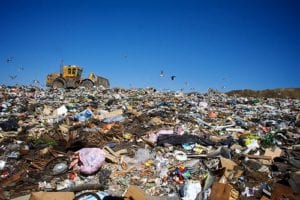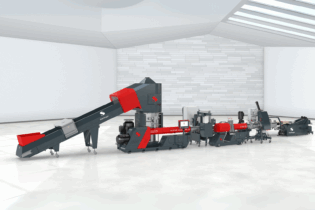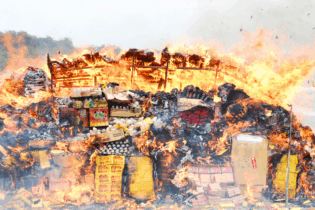When it comes to mobile equipment operation in sanitary landfills, there are multiple choices in terms of machine types, sizes and options. The purpose of this paper is to provide guidance to landfill site managers in these critical choices, by explaining how they can influence the final density of solid waste.
Best optimisation practices for site managers Sanitary landfills: A great step forward
Sanitary landfills offer a cost-effective way of disposing of municipal and industrial solid waste. Significant precautions are needed to minimise impact on the neighborhood. An engineered landfill will greatly reduce risks of soil and ground water contamination, as well as emissions of gas and odors. In terms of waste management, this is a great step forward for the health and safety of the community, compared to the habits of dumping waste that used to prevail in many parts of the world. Compared to other methods of treatment like incineration, bioreactors, and recycling of material, sanitary landfills have a lower cost of investment and operation, especially in areas where land is at an affordable cost for the community or the landfill operator. An engineered landfill does however represent a significant investment. Its capacity is limited and there are significant precautions needed to minimize impact on the neighborhood. To extend its life, sanitary landfill sites are often equipped with machinery to not only place waste into the landfill cell, but also maximize its compaction. The first direct benefit is a gain in volume utilization, hence extending the life of a landfill site and reducing the utilisation of land. Beyond the economical aspect of a better return on investment, compaction provides other benefits: landfills often suffer the NIMBY (Not in my Backyard) syndrome and site managers aim at building good relationship with the neighborhood. Compaction reduces some negative consequences of landfilling solid waste, such as:
• Odour, pests and birds
• Litter and wind-blown debris
• Fires
• Leachate treatment
• Land sliding and uneven settlement
Solid waste placement on a landfill
Most landfill cell dimensions should be kept to approximately 30 to 60 m wide, by 20 to 25 m long on slopes around 5 to 1 (lift height would be approximately 4 to 5 m) during working hours and brought in to 4:1 or 3:1 by end of day for use of less cover soil. A daily slope of 5 to1 gives faster cycles, less fuel, less maintenance; and by moving the slope in to a 4 to1 or 3 to 1 by day’s end, you reduce exposure of rainwater to the waste and machine operators are working in a manageable area of compaction.
Control of tipping area
The active face of a landfill is busy with the daily traffic of collection trucks and transfer trucks.
First of all, it is important to control the collection truck traffic, i.e. the landfill site spotter has control over the collection truck drivers and allows them to dump in designated areas. This way, you:
-Keep the landfill cell to the above dimensions,
-Reduce time to push waste from the dumping spot to the cell
-Improve safety on the site by allowing truck drivers only on a dedicated access road. Pushing waste to the landfill cell
Once waste has been dumped, it needs to be pushed to the landfill cell.
Question: “As municipal and industrial solid waste comes in various shapes and sizes, and is often enclosed in plastic bags, should it be shredded, compressed and chopped during landfilling? The answer is yes. When waste is compressed, reduced in size, and shredded properly, it will find more easily its place, (bind together), and reduce voids. Good compaction promotes mixing and blending of materials creating a more even surface. On modern landfills, you tend to use dedicated equipment for each task required. Although mobile equipment is often designed to increase their versatility, it is important to take a closer look at each machine configuration. In order to effectively chop and shred waste, it is recommended to use track type tractors (dozers) or track loaders, to spread waste. These machines are fitted with steel tracks. Track grousers will act as blades to chop and shred material. A track type tractor is ideal to spread waste on a slope. Its ability to push a load while controlling precisely the position of the blade ensures consistent layer thickness better than any other machine. Landfill compactors are equipped with a large capacity blade, enabling the machine to push large quantities of waste. However when it comes to pushing and spreading waste, it is important to consider that a track type tractor will have a better traction force, thanks to its track design, providing a better grip on the loose refuse. Also note that the more time pushing and spreading with a compactor, the less time for what it is designed for, compacting.
Thickness of the waste layer
Proper layering consists of pushing and spreading the waste in thin layers. Thin layers bind, compress, and shred easier than thicker layers. Machines use less fuel, gain higher densities, and have less maintenance issues with thinner layers. Thicker layers take away all of the above gains and only compacts the top of the layer leaving a spongy non compacted area beneath it that increase rolling resistance during compaction runs. The layer thickness will depend on the weight of the equipment used for compaction. See Table 1 for layer thickness recommendations. If the layer gets thicker than recommended values, the lower part of the layer will not receive enough pressure to reduce voids in the waste. The layer will act like a spring, and once the compactor has made a pass over the layer, it would return to its initial volume.
Dozers equipped with large capacity blades increase the site productivity. The tracks provide a good balance and floatation on loose waste, and will facilitate an efficient spread. Alternatively, sites not equipped with dozers can use landfill compactors. Small sites can use track loaders equipped with large capacity buckets.
CompressionNow that waste has been laid on the cell, it is ready to be compacted. Mobile equipment will apply a vertical force on the waste, which will compress waste and reduce voids. This force is linked to the pressure applied by the equipment Pressure = Weight / Contact surface A dozer has a large surface of contact with waste (4 to 6 m2 for a 240 HP dozer), therefore by default, its compaction capability is far less than a landfill compactor equipped with steel wheels. It is not obvious to evaluate the contact surface of a machine equipped with wheels, working on a loose surface, however a good estimate is the linear pressure, where instead of using the contact surface, you take into account the width of each wheel. By further reducing the wheel width, you increase pressure and compaction on waste. It is therefore not recommended to utilize mobile equipment equipped with 2 drums instead of 4 wheels, as they increase the contact surface with ground and decrease pressure, when it comes to compaction. Equipment manufacturers have to carefully choose the steel wheel size, as reducing wheel size does increase pressure but not necessarily compaction. For example, narrow wheels break free easier and spin easier: the sheer force of that wheel might be higher than the compacted waste causing wheel spin. Influence of number of passes on solid waste layer on final compaction
Each pass increases final compaction. Experience shows that the economical balance between number of passes and operating cost of mobile equipment is to make four passes on the layer. A pass is a travel in one direction of the compactor all across the active cell. According to the tests we realised, once you have done four passes on solid waste, the gain in density is minimal, compared to the time and fuel spent.
Practical example at a landfill study near Durban
In October 2009, we were asked by a landfill site to study their techniques to review their equipment operation and develop new operation methods to improve waste density in place. Conclusions
Durban Solid Waste was already using a fleet of dedicated machines, i.e. landfill compactors and Waste Handling Arrangements Track Type Tractors. The remaining landfill life was estimated to be four years, when the study was completed. The results showed an improvement in compaction from 605 kg/m3 to 655 kg/m3, which means, by using new operating techniques, without any additional equipment we could further increase compaction by 8% and extend the landfill life by more than three months. The other important point to notice was that we achieved these gains on compaction without reducing the site production, i.e. how much solid waste they were able to treat per hour. By dedicating landfill compactors to compaction, and dozers to pushing and spreading, we increased the overall production of the fleet. The measurements showed that overall production increased by 8% from 139 tons/hr to 150 tons/hr. In terms of fuel consumption, we measured an increase by 14% of the combined consumption of a landfill compactor and a dozer, compared to the consumption of a landfill compactor used to push, spread and compact waste. Brought back to the cost savings in terms of landfill space, this is a cost increase that the site was happy to bear. In conclusion, we showed the importance of selecting and using right machines for the tasks, namely, to dedicate a landfill compactor to compaction tasks, and a dozer to pushing/spreading tasks. All employees could understand they played a role in improving density of solid waste in particular, and management felt they were better utilising the assets of the landfill, without any additional investment.
By Stéphane Bertrand








